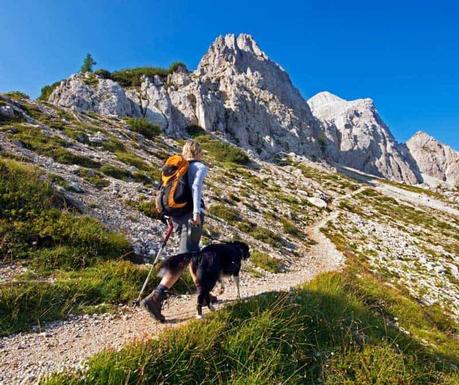Strength training is an important part of preparing for your hiking trip. You're likely working on your cardio, but are you ignoring this important part of your training?

You've reserved your big hiking trip, like the Tour du Mont Blanc, Dolomites or one of the other incredible hikes that we offer. You're excited to take in all the splendid views! But you want to be sure that you're fit enough to actually enjoy those views.
That's why it's so important to prepare for your big hike. And I've got the perfect hiking training plan for you.
Before getting started with any new fitness plan it's always good to have a medical check-up. If you have any old nagging injuries, get these assessed by your doctor or physiotherapist.<
It's important to take these small aches and pains into account when training for hiking. You should also factor in how much time you have to train.If you have any joint pain/injury (ankles, knees or shoulders) it is imperative that you seek professional advice in advance. You'll want to ensure that you work specifically on those areas to prevent any serious problems during your hiking trip.
Hiking poles will some of the pressure off your joints but you'll still want to strengthen these areas before.
How to Train for a Hike When You Don't Live Near the Mountains
Now you might be asking yourself, how do I train for hiking when I do not live near a mountain nearly as big as where I plan on hiking? I have good news for you.
There are many ways to prepare. The first step is mapping out just how many weeks you have left until your trip. Then determine how many hours per week you have to dedicate in order to meet your goal.
It is important that you set realistic and achievable goals for yourself.Once you've got that sorted you can get down to the fun stuff and get out and get moving.
Here are some ways that you can train:

- Plan on walking 3 - 5 times per week.Vary your speed and distances. Be sure to include one long-distance walk per week. If possible take the hilliest routes in your area.Consider bringing a backpack with you so that you can get accustomed to carrying weight. Each week can add more weight to the pack.
- Take the stairs. This is important not only to build your cardiovascular endurance but it will also strengthen your quads which will help you with the ascents throughout your hike.
- BUILD YOUR CORE! This is one that is often overlooked.Having a strong core (I'm not talking six-pack abs) will help you more than you think.When carrying a heavy backpack and as fatigue sets in, a strong core foundation is invaluable to get you up the mountain.
- If you have a gym membership, take advantage of the incline setting on the treadmill and the stair climber. Look for other equipment geared towards building leg strength.
It is important that you get in the miles on your feet.Whenever possible use the same hiking boots you plan to wear on your trip.If you plan on getting new ones, now is the time to break them in.
Strength Training for Hiking: Specific Exercises
Here is what you should prioritize in order to get the biggest bang for your buck. Depending on how much time you have on hand add one or all of the following routines to your weekly walks or even better hikes to round out your training.
Leg strength is paramount. If you have wobbly legs your hike will feel very long and difficult and not enjoyable. And you want to enjoy this. You can see photos and more explanations of each of the exercises mentioned below by clicking here:
Strength Training Leg Routine for Hikers:
Repeat this pyramid 2-4 times.
10 - Glute Bridges
20 - Reverse Lunges (10 each side)
20 - Steps ups (10 each side)
10 - Side lunges (5 each side)
Strength Training for Your Core (Important for Hikers)
Core strength as the foundation of your house.Without it, we would crumble forwards. These exerecies will activate and reconnect you with your core:
Repeat this routine 2-4 times.
20 - Bird Dogs (10 each side)
15 - Overhead reaches (Deadbug if more advanced)
15 - Side plank with hip dips (knees bent or legs fully extended) (each side)
15 - Supermans
Strength Training for the Upper Body for Hikers
Last but not least, this routine targets your upper back and shoulders to build that much-needed strength when carrying your backpack all day. Note this plan is if you're planning on carrying a day pack. If you're planning on backpacking, see the plan below this section.
Repeat this routine 2-4 times.
10 - Cat cows
15 - Shoulder retractions
10 - Wall angels
15 - Push ups
10 - Pike push ups
30-second plank
It is also important that throughout your hiking preparation that you take time to stretch and rest.After each training session be sure that you stretch your quads, hamstrings, glutes, back and arms.
Muscle tightness can lead to imbalances and ultimately pain or injury.Be sure that you do no "overtrain" and that you include at least 1 full day of complete rest to allow your body to regenerate and recharge.
Preparing For Carrying A Backpack During Your Hike
First things first. Ensure that you choose the right backpack for your body type and the type of hike that you'll be doing. You'll find lots of great tips and recommendations in our article 13 Best Hiking Backpacks of 2019.
Strength Training Specifically For Backpacking
It's important to strengthen your posterior chain, neck and shoulders. Doing so will minimize aches and pains throughout your hike. Before we get into a specific backpack training program, let's start by the most obvious way to train.
Carry a weighted backpack during your weekly training.Each week you can add additional weight to your pack in order to build up strength and endurance.
Strengthening the "Posterior Chain"
Now let's get back to that "posterior chain".What's that you ask? The posterior chain is a group of muscles comprised of the calves, hamstrings, gluteus muscles, multifidus, erector spinae, trapezius, and posterior deltoids.
This group of muscles are essential in keeping us erect and keeping our hips stable.More often than not we have an imbalance between the anterior chain and the posterior chain from an over-focus on quad and ab exercises.
This can lead to pain and weakness in our backs and our hips. So how does this tie into hiking? Carrying a heavy backpack for multiple days a ta time is taxing on the body. And it's especially taxing on your lower back, neck and shoulders.
Strength Training Workout for Backpackers
Here are some simple exercises that you can incorporate into the above hiking training program.
- Good mornings or Romanian deadlifts
- Glute bridges
- Hip thrusters
- Kettle bell swings
- Bent over rows or cable pull-throughs
- Calf raises
- Wall angels
Ensure that you do the stretches listed above when you're finished.
Hiking can bring you to the most marvellous and wondrous places but having a weak back can ruin the experience.These training recommendations will have you well on your way to ensuring you are prepared to take on the mountains!
By doing cardio and strength training you'll be ready for your hiking trip and you'll minimize your chance of injury and fatigue. Most importantly, you'll feel good enjoy to enjoy your multi-day hike!
Amanda Isaac is a certified Personal Trainer and Nurse based in Munich, Germany. She specializes in core and pelvic floor training and provides one to one training. Get your free "Core Foundations" program by subscribing to the newsletter at https://www.amandaisaaccoaching.com/subscribe.

